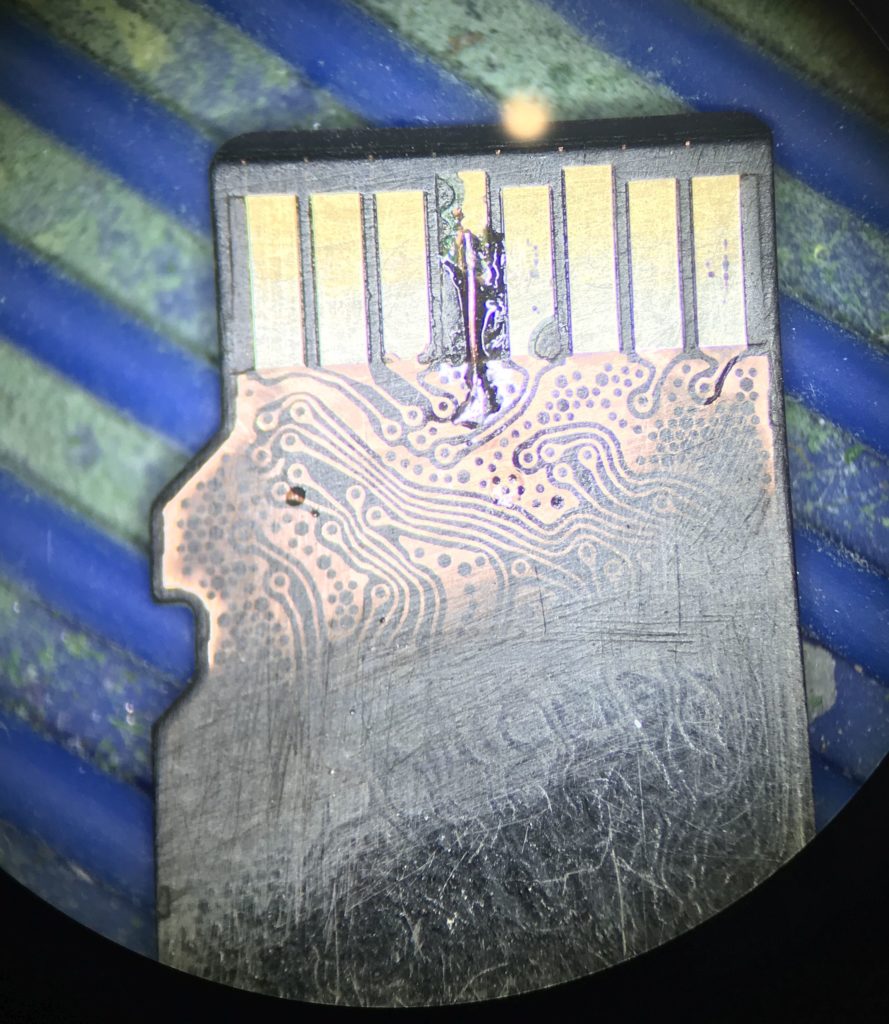Opening up a watertight box and finding this inside is never encouraging.

The toxic soup trapped inside the box wasn’t doing any favors to the batteries or electronics, and the data logger was dead on arrival. But we pulled the microSD card to see if there was anything that could be salvaged off of it.

What you see in the closeup above (sorry for the blurry shot through a microscope eyepiece) is that the 4th pin (the positive voltage supply pin, Vdd) has been partially corroded away, and a bit of the 5th pin (the SCLK clock pin when used in SPI mode) has gone as well. When tested in a card reader, there was no response, which makes sense if the card wasn’t getting a positive voltage supply from pin 4.
To attempt to salvage the data, the goal was to reconnect pin 4 to the circuitry inside the card’s plastic coating, and make sure none of the other pins were similarly disconnected due to corrosion.

To gently remove the black plastic coating covering from the card near the pins, I used a bit of green Scotchbrite scrubbing pad from a kitchen sponge. The green Scotchbrite is more aggressive (the package labels it as “heavy-duty”) than the blue non-scratch Scotchbrite you might have in your kitchen, so green is the preferred color here.

After about 10 minutes of vigorous (dry) scrubbing with the Scotchbrite, the copper substrate started to show through. With all the wavy traces and different sized holes, it doesn’t look like a normal circuit board, but you’re still just looking for connections between the gold-plated pins and the copper traces that were sealed under the black plastic. In the photo above you can see that pin 4 has been further rubbed off by the Scotchbrite, and you can see the relatively large area of copper that it attached to directly below it. The neighboring pins connect to much thinner traces, so they would be more challenging to repair.
You might also notice that pin 6 (the ground pin) was starting to lose some of its connection to the copper beneath it, but it was intact when tested with a continuity test on my handheld multimeter. I tested all of the pins 1-8 one by one with the multimeter to make sure that the gold pin was still attached to the copper trace that I had exposed with the Scotchbrite.
Pin 4 was the only fully-disconnected pin in this case. I extracted a single fine strand of copper wire from a scrap piece of USB cable to use for the repair. Then it was a matter of using the soldering iron, some solder, and additional flux to solder the wire strand down to the copper pad for the Vdd portion of the circuit, and then solder the other end to the remains of the gold pad of Pin 4.

The repair isn’t pretty, but it was sufficient to reestablish the electrical connection, and when I plugged it in to my microSD card reader the card showed up on the computer just like normal. You can see some extra directories from the last time it was plugged into a GoPro camera, and then data files from the datalogger. Because my datalogger was programmed to start a new file every night at midnight, I managed to retrieve several days of intact data up through April 11 around 10:17GMT (3:17 AM local time).

There were also two files with gibberish file names that must be due to the datalogger’s real time clock failing and returning 2165-165-165 as the date. Those were the last gasp of the datalogger before it stopped writing data to the microSD card.
While I probably won’t put this card back into service, it was nice to be able to salvage some of the data off it, even after it had sat in a stew of estuary water and battery juice for about 20 days.